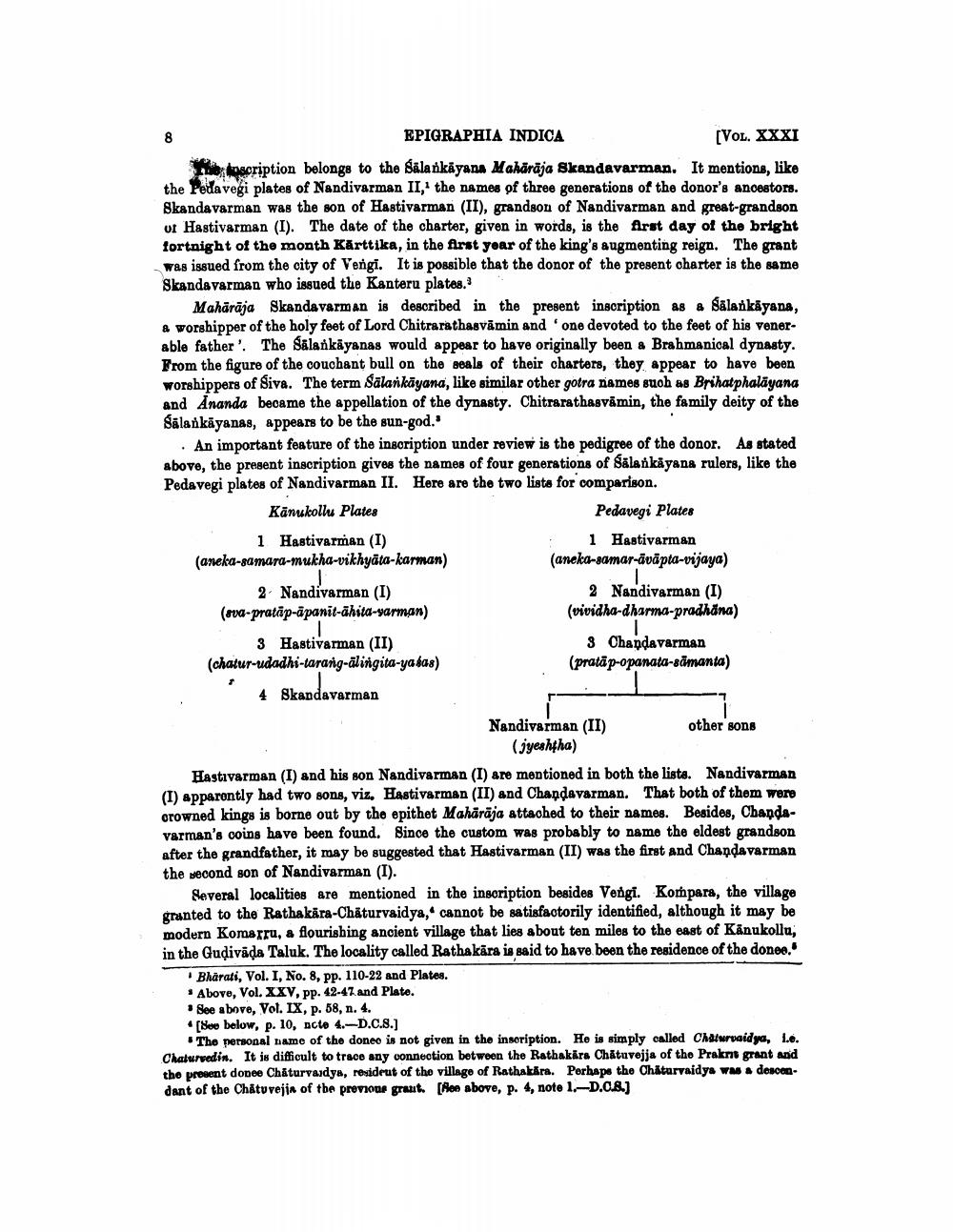________________
EPIGRAPHIA INDICA
[VOL. XXXI the duscription belongs to the Sälankāyana Mahārāja Skandavarman. It mentions, like the Pedavegi plates of Nandivarman II, the names of three generations of the donor's ancestors. Skandavarman was the son of Hastivarman (II), grandson of Nandivarman and great-grandson ut Hastivarman (I). The date of the charter, given in words, is the first day of the bright fortnight of the month Kärttika, in the first year of the king's augmenting reign. The grant Was issued from the city of Vengi. It is possible that the donor of the present charter is the same Skandavarman who issued the Kanteru plates.
Mahārāja Skandavarman is described in the present inscription as a Sälankäyana, & worshipper of the holy feet of Lord Chitrarathasvāmin and one devoted to the feet of his venerable father'. The Salarkiyanas would appear to have originally been a Brahmanical dynasty. From the figure of the couchant bull on the seals of their charters, they appear to have been worshippers of Siva. The term Salarikāyana, like similar other gotra names such as Brihatphalāyana and Ananda became the appellation of the dynasty. Chitrarathasvāmin, the family deity of the Salankāyanas, appears to be the sun-god."
. An important feature of the inscription under review is the pedigree of the donor. As stated above, the present inscription gives the names of four generations of Salankäyana rulers, like the Pedavegi plates of Nandivarman II. Here are the two lists for comparison. Kānukollu Plates
Pedavegi Plates 1 Hastivarman (I)
1 Hastivarman (aneka-samara-mukha-vikhyāta-karman)
(aneka-samar-āvāpta-vijaya) 2 Nandivarman (I)
2 Nandivarman (I) (ova-pratāp-āpanit-ähita-yarman)
(vividha-dharma-pradhana) 3 Hastivarman (II)
3 Chandavarman (chatur-udadhi-tarang-älingita-yalas)
(pratāp-opanata-sämanta) * 4 Skandavarman
Nandivarman (II)
other sons
(jyeshtha) Hastivarman (I) and his son Nandivarman (I) are mentioned in both the lista. Nandivarman (I) apparontly had two sons, viz. Hastivarman (II) and Chandavarman. That both of them were orowned kings is borne out by the epithet Mahārāja attached to their names. Besides, Chandavarman's coins have been found. Since the custom was probably to name the eldest grandson after the grandfather, it may be suggested that Hastivarman (II) was the first and Chandavarman the second son of Nandivarman (I).
Several localities are mentioned in the inscription besides Vengi. Kompara, the village granted to the Rathakira-Chaturvaidya, cannot be satisfactorily identified, although it may be modern Komarru, a flourishing ancient village that lies about ten miles to the east of Kanukollu, in the Gudivada Taluk. The locality called Rathakära is said to have been the residence of the donee."
Bharati, Vol. I, No. 8, pp. 110-22 and Plates. Above, Vol. XXV, pp. 42-47 and Plate. * See above, Vol. IX, p. 58, n. 4.
[See below, p. 10, acto 4.-D.C.S.)
* The personal name of the doneo is not given in the inscription. He is simply called Chaturvaidya, Le. Chaturvedin. It is difficult to trace any connection between the Rathakira Chatuvejja of the Praknt grant and the present donee Chaturvadya, resideut of the village of Rathakira. Perhaps the Chaturvaidya was a descendant of the Châtuvejin of the previour grazit (fee above, p. 4, note 1.-D.C.B.)




